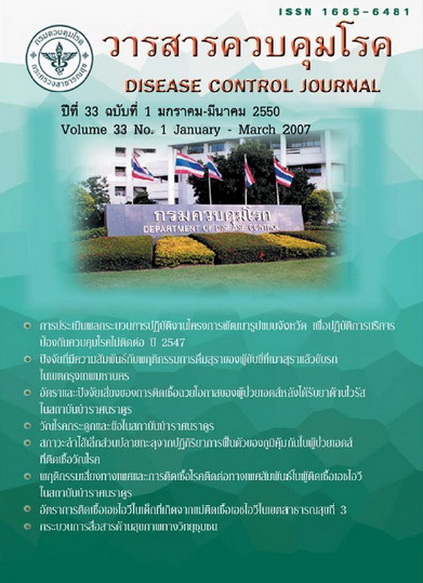Factors Associating with Alcohol Consumption Behavior Among Drunk Drivers in Bangkok Metropolis
Keywords:
Alcohol Consumption Behavior, Drunk Drivers, Bangkok MetropolisAbstract
This cross-sectional survey study was aimed to investigate alcohol consumption behavior and identify factors associated with alcohol consumption among drunk drivers in Bangkok Metropolis. The 390 subjects were selected by systemic sampling method from drunk drivers who had been taken into custody of driving because having upper blood alcohol concentration limits of 0.5 g/dl. The data were collected by questionnaire on February 2006 and were analyzed for frequency, percentage, mean, standard deviation and Pearson's Product Moment Correlation Coefficient. The results showed that 40.3% of the samples had alcohol consumption 2-3 times per week while 5.6 % had daily. The predisposing factors that had significantly positive association with alcohol consumption behavior were attitudes toward impaired drivers and perceived risk of traffic accident from the drunk drivers. The enabling factors that had significantly positive association with alcohol consumption behavior were place of beverage drinking. The reinforcing factors that had significantly positive association with alcohol consumption behavior were the influence of information received from media and supports to alcohol consumption from the parents. In spite of drunk drivers known and perceived accidental and violent risk, they still practiced drink and drive because they thaught that they had less chance of being arrested as alcoholic checkpoints to assess their level of alcohol consumption had been irregularly set up, only during major festivals and celebrations. The most important was that part of sample group thaught that they had enough ability to drive if they had consciousness regardless of having drink and reached upper blood alcohol concentration limit (0.05 mg%). In fact their family did not complain or blame them and sometimes invited to enjoy drinking. According to Thai traditional, most of party meetings always contained alcoholic drink with either advertisements or sponsors. Thus resolving this problem, the programme should use several preventive measures for reducing drunk drive such as enforcing alcohol laws by random breath-testing and adequate alcoholic checkpoints with consistency and continuity, uncompromised punitive measures, wide spread information, education and communication campaigns about risk factors, in particular, the effect of alcohol abuse. All of these measures should be raised to enlarge safety-awareness and improving their behavior later.
Downloads
References
2. นิพนธ์ พัวพงศกร, อัมมาร สยามวาลา, สมชาย สุขสิริเสรีกุล, สิทธิศักดิ์ ลีลหานนท์, เอื้อมพร สาริกา, นายเสก เมธาสุรารักษ์ และนายสมเกียรติ เรืองจันทร์. บทคัดย่อรายงานฉบับสมบูรณ์โครง การวิจัยพัฒนารูปแบบ เพื่อการป้องกันการดื่มสุราและเครื่องดื่มแอลกอฮอล์. เอกสารประกอบการประชุม เวทีวิชาการเพื่อควบคุมการบริโภค แอลกอฮอล์ มูลนิธิสาธารณสุขแห่งชาติ 26 พฤษภาคม 2548 ณ ศูนย์ประชุมสถาบันวิจัย จุฬาภรณ์ กรุงเทพมหานคร. 2548.
3. คณะทำงานวิจัยสุรา. สุรากับสังคมไทย ข้อสนเทศ และผลงานวิจัย ความรู้ เจตคติ การดื่มและแนวทางแก้ไข. กรุงเทพ: จุฬาลงกรณ์มหาวิทยาลัย; 2537.
4. Gururaj, G. Road Traffic Injuries, Alcohol and Road Traffic Injuries in South Asia : Challenges for Prevention. JCPSP. 2004; 14(12): 713 - 718.
5. สำนักงานสถิติแห่งชาติ กระทรวงเทคโนโลยีสารสนเทศ และการสื่อสาร. รายงานผลการสำรวจอนามัย และสวัสดิการ พ.ศ. 2546. กรุงเทพมหานคร. 2547.
6. Pibul, S. Drinking and Driving Don't Mix:Lifeline World Health Organization. 2004; 1(1): 14
7. กองบังคับการตำรวจจราจร สำนักงานตำรวจแห่งชาติ.เอกสารประกอบการประชุมหารือการบังคับใช้กฎหมายเพื่อป้องกันและลดอุบัติเหตุ ณ กองบังคับการตำรวจจราจร กรุงเทพมหานคร วันที่ 17 กุมภาพันธ์ 2549.
8. ประกิจ โพธิอาศน์.ปัจจัยที่มีอิทธิพลต่อพฤติกรรมการดื่มเครื่องดื่มที่มีแอลกอฮอล์ของวัยรุ่นจังหวัด พระนครศรีอยุธยา. วิทยานิพนธ์ปริญญาวิทยาศาสตร์ มหาบัณฑิต สาขาวิชาสุขศึกษาและพฤติกรรมศาสตร์. บัณฑิตวิทยาลัย มหาวิทยาลัยมหิดล. 2541.
9. พัชรินทร์ ชมเดช. พฤติกรรมการดื่มสุราและปัจจัยที่เกี่ยวข้อง ของผู้ป่วยกลุ่มวัยทำงานที่ประสบอุบัติเหตุจราจรที่มารับบริการรักษาพยาบาล ณ ห้องอุบัติเหตุและฉุกเฉินโรงพยาบาลพระนั่งเกล้า จังหวัดนนทบุรี. วิทยานิพนธ์วิทยาศาสตร์มหาบัณฑิต สาขาวิชาสุขศึกษา. มหาวิทยาลัยเกษตรศาสตร์. 2548.
10. สิทธินันท์ เจริญรัตน์. พฤติกรรมการดื่มเครื่องดื่มแอลกอฮอล์ นักเรียนมัธยมศึกษาตอนปลายอำเภอเมือง จังหวัดปทุมธานี. วิทยานิพนธ์วิทยาศาสตร์มหาบัณฑิต สาขาวิชาสุขศึกษา.มหาวิทยาลัยเกษตรศาสตร์. 2543.
11. นันท์ธิยา วิสุทธิ์ภักดี. ปัจจัยที่มีอิทธิพลต่อพฤติกรรมการ ป้องกันตนเองจากการ ดื่มสุราของนิสิตชายในหอพักมหาวิทยาลัยเกษตรศาสตร์.วิทยานิพนธ์วิทยาศาสตร์มหาบัณฑิต สาขาวิชาสุขศึกษา. มหาวิทยาลัยเกษตรศาสตร์. 2545.
12. จิราภรณ์ เทพหนู. ปัจจัยที่มีผลต่อการดื่มเครื่องดื่มแอลกอฮอล์ของนักเรียนมัธยมศึกษาตอนปลายสายสามัญศึกษา ในจังหวัดพัทลุง.วิทยานิพนธ์ปริญญาวิทยาศาสตร์มหาบัณฑิตสาขาวิชาอนามัยครอบครัว. บัณฑิตวิทยาลัย
มหาวิทยาลัยมหิดล. 2540.
13. ไพบูลย์ สุริยะวงศ์ไพศาล. ตำราระบาดวิทยาอุบัติเหตุจราจร. กรุงเทพมหานคร: โฮลิสติก พับบลิชชิ่ง; 2546.
14. ยงยุทธ ขจรธรรม และบังอร ฤทธิภักดี. นโยบายและมาตรการในการควบคุมการบริโภคแอลกอฮอล์.กรุงเทพมหานคร: มูลนิธิสาธารณสุขแห่งชาติ; 2547.
15. สำนักโรคไม่ติดต่อ. เอกสารประกอบการประชุมคณะกรรมการป้องกันและควบคุมการบาดเจ็บกระทรวงสาธารณสุข ครั้งที่2 /2549. กรมควบคุมโรคกระทรวงสาธารณสุข. 2549.
16. Pinsky, I., E. Lavouvie, R. Pandina and R.Laranjeira. Drinking and Driving : Pre-drivingAttitude and Perceptions Among Brazillian Youth. Drug Alcohol Depend. 2001. May 1; 62 (3): 231.
17. Shults, R.A., R.W. Elder, D.A. Sleet, J.L. Nichols, M.O. Alao, V.G. Garande-Kulisand the Task Force on Community Prevention Services. Reviews of evidence regarding interventions to reduce alcohol-impaired driving. American Journal of Preventive Medicine. 2001; 21 (45): 66-88.
18. Henry, S. and D. Dhaval. Alcohol advertising and alcohol consumption by adolescents. NBER Working paper. May 2003, no. 9676.
19. Saffer, H. Alcohol Advertising and Youth. Journal of Studies on Alcohol. 2002; 14: 173-81.
20. Sokol-Katz, J.,R. Dunham, and R.Zimmerman. Family structure versus parental attachment in controlling adolescent deviant behavior: a social control model. Adolescent. 1997; 32: 125
21. ภาวิณี อยู่ประเสริฐ. ปัจจัยที่มีผลต่อการใช้สารเสพติดของนักเรียนวัยรุ่นในกรุงเทพมหานคร.วิทยานิพนธ์ปริญญาวิทยาศาสตร์มหาบัณฑิต สาขาพยาบาลสาธารณสุข. บัณฑิตวิทยาลัย มหาวิทยาลัยมหิดล. 2540.
22. ชัยยุทธ ดายา. ปัจจัยของการขัดเกลาทางสังคมของพ่อแม่ที่กระทบต่อพฤติกรรมการดื่มเครื่องดื่มแอลกอฮอล์ของวัยรุ่นกรณีศึกษามัธยมศึกษาตอนปลายของกรมสามัญ. วิทยานิพนธ์ปริญญาสังคมวิทยาศาสตร์มหาบัณฑิต คณะสังคมวิทยาและมานุษยวิทยา. มหาวิทยาลัยธรรมศาสตร์. 2534.
23. ศูนย์อำนวยการความปลอดภัยทางถนน. การแก้ไขปัญหาอุบัติเหตุทางถนนในประเทศไทย.วันอนามัยโลก Road Safety is No Accident.กรุงเทพฯ: องค์การสงเคราะห์ทหารผ่านศึก; 2547.
Downloads
Published
How to Cite
Issue
Section
License
Articles published in the Disease Control Journal are considered as academic work, research or analysis of the personal opinion of the authors, not the opinion of the Thailand Department of Disease Control or editorial team. The authors must be responsible for their articles.






